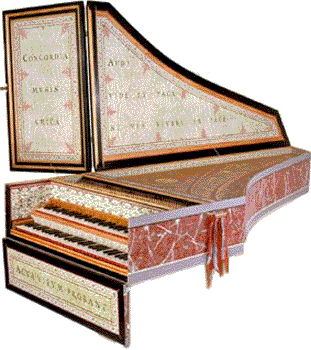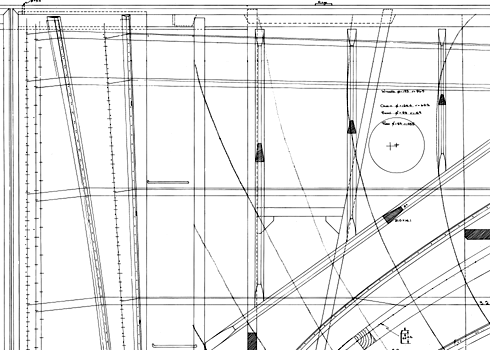![]()
D R A W I N G S
made by Grant O'Brien
'French' Ruckers aligned double-manual harpsichord drawing
This harpsichord has a chromatic compass of G1 to d3 (originally G1 to c3).


One of the discoveries that I made during my research into the Ruckers family tradition was that there was a new model of Ruckers double-manual harpsichord that was larger than the 'standard' Ruckers 'transposing' harpsichord. Because all of the surviving examples of this model of harpsichord are to be found in France, it seems likely that they were all made especially for the French market. I therefore coined the expression "Ruckers 'French' harpsichord" for these instruments in a way analogous to those single-manual harpsichords described in Flemish as 'op sijn engels' or 'in the English style'. The latter, now found in England, were instruments which were made by the Ruckers family for the English market. This English model of single-manual harpsichord with a chromatic bass octave instead of the usual C/E bass short-octave.
The large model of 'French' Ruckers double-manual had an upper manual 4-octave chromatic compass from F to f3 at a pitch of R - 4, and a lower manual with a 4½-octave chromatic compass of G1 to c3 at normal pitch R. This compass, unlike the compass of a 'normal' Ruckers double-manual harpsichord which has only a short-octave C/E bass octave, has a full chromatic bass octave right down to G1. Such a compass is of course very useful when making an instrument based on a Ruckers harpsichord since it enables a much larger repertoire to be played on this instrument. But since there is a large part of the harpsichord literature that needs a top d3, I decided to extend the treble compass from c3 to d3. This, if anything, improves the sound of the 'original' c3 as well as increasing the literature that can be played on such an instrument. It would require only a slight modification to increase the treble compass to e3 or f3.
The drawing is of an ALIGNED ('French') extended-compass harpsichord with a compass of G1 to d3 and with both manuals at normal pitch (A = 415.3Hz). The disposition of the registers is:
4' ←
8' →
8' ← dogleg
8' ←
This disposition gives many useful possibilities with many advantages. The two rear rows of jacks preserve the original Ruckers plucking points with all of their original musical properties. The two near registers can be made so that they are connected with a mechanical switch so that, when one of the registers is engaged, the other is automatically disengaged. With the register nearest the player disengaged and all of the others engaged one has the usual 'piano' and 'forte' combination with two 8's and a 4' on the lower manual and a single 8' on the upper (the dogleg register). Playing two 8's on the lower manual gives a 2x8' possibility without a 4' row between the two 8' rows, so that the two 8's blend and choir well since their plucking points are very close to one another. For pieces croisées the dogleg is disengaged and the near, upper-manual 8' is engaged. With the 4' disengaged there is then a single 8' on each manual each one of which is distinct, with its own tonal quality because it is separated from the other register by the dogleg row of jacks. One of the chief advantages of the scheme is that, like the English disposition with a lute stop, once it has been regulated the jacks and coupler stay in regulation because there is no French shove-coupler system to go out of regulation.
A harpsichord made on the basis of this drawing thus retains all the properties of the original Ruckers design and its acoustical and musical properties. In addition, it can play an enormous repertoire of music from the sixteenth to the eighteenth centuries. It has a sweet, pure sound typical of the instruments built in the Ruckers tradition which has made them so famous both in historical and in modern times . The drawing includes drawings of the main instrument, the lid, case, bridge dimensions, hardware, soundboard thicknesses, keyboards, etc. There is everything you need here to make a practical, useful and stunningly beautiful instrument!
Some details of this instrument
Stringing the 'French' Ruckers harpsichord
Return to the main catalogue of drawings
